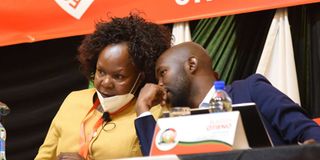FKF hold first AGM in Mwendwa's second term

Football Kenya Federation Deputy President Doris Petra (left) consults CEO Barry Otieno during their Annual General Meeting at Safari Park hotel in Nairobi on February 6, 2021.
What you need to know:
- In a recorded video address, Mwendwa urged the delegates to ensure that there is development of grassroots football in their regions, especially women’s teams
- With Fifa increasing from three to six the slots reserved for Africa in the 2023 women’s showpiece, Mwendwa believes Harambee Starlets stand a chance of making their maiden appearance in the competition
- Of the Sh1.4 billion budget, Sh915.7 million will come from local receipts, which include various sponsorships, Sh420 million will be Fifa grant, while the Confederation of African Football will provide Sh20 million
Calls for more grassroots football activities dominated Saturday’s Football Kenya Federation (FKF), Annual General Meeting held in Nairobi.
At the same time, the delegates also adopted the federation's Sh1.4 billion budget for the year 2021.
The AGM was the first since FKF president Nick Mwendwa and his deputy Doris Petra were re-elected into office in October last year.
In a recorded video address, Mwendwa urged the delegates to ensure that there is development of grassroots football in their regions, especially women’s teams, as their aim is to have Harambee Starlets feature in the 2023 Women’s World Cup in Australia and New Zealand.
“Make sure in every county, more teams are enrolled. Ensure we have youth teams, as you know youth are the foundation of our game. Make sure your leagues are vibrant. I have no doubt if we do this, in the next four years, we will be where we want to be,” said Mwendwa.
He added: “Every county, especially where possible should have a youth and senior women’s team. Enroll your teams and let’s ensure the women's team (Harambee Starlets) grows because our dream is to be in the World Cup in 2023.”
Harambee Starlets have never featured in the World Cup, the 2016 Africa Women Cup of Nations in Cameroon being the most competitive event they have ever taken part in thus far.
With Fifa increasing from three to six the slots reserved for Africa in the 2023 women’s showpiece, Mwendwa believes Harambee Starlets stand a chance of making their maiden appearance in the competition.
“We feel we have an opportunity (qualify for the 2023 World Cup) for sure. We want to make our women’s football grow by being in the World Cup,” he said.
Petra, who chaired the AGM said it is through more grassroots football activities that Kenya will benefit from Fifa grants set aside for the development of women’s football.
“In every county and sub-county, let us work hard so that we have prosperous grassroots football going on both for men and women. We need to do much more in the development of women football. We have a lot of support from Fifa now for women football but we can only benefit from it, if we are doing something on the ground. At that level, nobody from the national office will come to do it for you,” said Petra.
She pointed out the recently unveiled FKF Women’s Cup, as one way they hope to grow Kenya’s women’s football, adding that talks are underway to establish a talent development centre in every county for the same purpose.
“As FKF, we are discussing the possibility of having youth development centres in every county, where all talents are developed. It is more critical for developing women’s football because the only safe place where girls currently play football is within the schools,” she said.
Of the Sh1.4 billion budget, Sh915.7 million will come from local receipts, which include various sponsorships, Sh420 million will be Fifa grant, while the Confederation of African Football will provide Sh20 million.
Safaricom will pump Sh49 million for Chapa Dimba na Safaricom.
According to the FKF budget, Sh989 million will be used to run the league and other competitions, Sh211.6million will be used for technical development while permanent administrative and technical staff will cost Sh62 million.
Sh39 million will be used for administration, Sh14 million will go into governance, Sh12 million will be used for marketing and communication, while other costs and capital costs will consume Sh17 and Sh9 million respectively.




